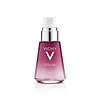What's inside
What's inside
 Key Ingredients
Key Ingredients

 Benefits
Benefits

 Concerns
Concerns

 Ingredients Side-by-side
Ingredients Side-by-side

Pentaerythrityl Tetraisostearate
EmollientCetyl Ethylhexanoate
EmollientTriethylhexanoin
MaskingPEG-20 Glyceryl Triisostearate
EmollientPentaerythrityl Tetraethylhexanoate
EmollientOctyldodecyl Myristate
EmollientHydrogenated Poly(C6-14 Olefin)
EmollientPEG-8 Isostearate
EmulsifyingCaprylic/Capric Triglyceride
MaskingHydrogenated Polyisobutene
EmollientIsostearic Acid
CleansingParfum
MaskingCocos Nucifera Oil
MaskingVitis Vinifera Seed Oil
EmollientSqualane
EmollientMacadamia Ternifolia Seed Oil
EmollientPinus Koraiensis Seed Oil
PerfumingSesamum Indicum Seed Oil
EmollientCamellia Japonica Seed Oil
EmollientPrunus Armeniaca Kernel Oil
MaskingPrunus Mume Seed Extract
Skin ConditioningNelumbo Nucifera Seed Extract
AntimicrobialTocopherol
AntioxidantPentaerythrityl Tetraisostearate, Cetyl Ethylhexanoate, Triethylhexanoin, PEG-20 Glyceryl Triisostearate, Pentaerythrityl Tetraethylhexanoate, Octyldodecyl Myristate, Hydrogenated Poly(C6-14 Olefin), PEG-8 Isostearate, Caprylic/Capric Triglyceride, Hydrogenated Polyisobutene, Isostearic Acid, Parfum, Cocos Nucifera Oil, Vitis Vinifera Seed Oil, Squalane, Macadamia Ternifolia Seed Oil, Pinus Koraiensis Seed Oil, Sesamum Indicum Seed Oil, Camellia Japonica Seed Oil, Prunus Armeniaca Kernel Oil, Prunus Mume Seed Extract, Nelumbo Nucifera Seed Extract, Tocopherol
Water
Skin ConditioningAlcohol Denat.
AntimicrobialHydroxyethylpiperazine Ethane Sulfonic Acid
BufferingButylene Glycol
HumectantGlycerin
HumectantDimethicone
EmollientPEG-20 Methyl Glucose Sesquistearate
EmulsifyingCI 14700
Cosmetic ColorantNeohesperidin Dihydrochalcone
MaskingSodium Hyaluronate
HumectantPhenoxyethanol
PreservativeAdenosine
Skin ConditioningAmmonium Polyacryloyldimethyl Taurate
Emulsion StabilisingDipotassium Glycyrrhizate
HumectantDisodium EDTA
Tocopherol
AntioxidantCaprylyl Glycol
EmollientCapryloyl Salicylic Acid
ExfoliatingCitric Acid
BufferingXanthan Gum
EmulsifyingT-Butyl Alcohol
PerfumingOctyldodecanol
EmollientParfum
MaskingWater, Alcohol Denat., Hydroxyethylpiperazine Ethane Sulfonic Acid, Butylene Glycol, Glycerin, Dimethicone, PEG-20 Methyl Glucose Sesquistearate, CI 14700, Neohesperidin Dihydrochalcone, Sodium Hyaluronate, Phenoxyethanol, Adenosine, Ammonium Polyacryloyldimethyl Taurate, Dipotassium Glycyrrhizate, Disodium EDTA, Tocopherol, Caprylyl Glycol, Capryloyl Salicylic Acid, Citric Acid, Xanthan Gum, T-Butyl Alcohol, Octyldodecanol, Parfum
 Reviews
Reviews

Ingredients Explained
These ingredients are found in both products.
Ingredients higher up in an ingredient list are typically present in a larger amount.
Parfum is a catch-all term for an ingredient or more that is used to give a scent to products.
Also called "fragrance", this ingredient can be a blend of hundreds of chemicals or plant oils. This means every product with "fragrance" or "parfum" in the ingredients list is a different mixture.
For instance, Habanolide is a proprietary trade name for a specific aroma chemical. When used as a fragrance ingredient in cosmetics, most aroma chemicals fall under the broad labeling category of “FRAGRANCE” or “PARFUM” according to EU and US regulations.
The term 'parfum' or 'fragrance' is not regulated in many countries. In many cases, it is up to the brand to define this term.
For instance, many brands choose to label themselves as "fragrance-free" because they are not using synthetic fragrances. However, their products may still contain ingredients such as essential oils that are considered a fragrance by INCI standards.
One example is Calendula flower extract. Calendula is an essential oil that still imparts a scent or 'fragrance'.
Depending on the blend, the ingredients in the mixture can cause allergies and sensitivities on the skin. Some ingredients that are known EU allergens include linalool and citronellol.
Parfum can also be used to mask or cover an unpleasant scent.
The bottom line is: not all fragrances/parfum/ingredients are created equally. If you are worried about fragrances, we recommend taking a closer look at an ingredient. And of course, we always recommend speaking with a professional.
Learn more about ParfumTocopherol (also known as Vitamin E) is a common antioxidant used to help protect the skin from free-radicals and strengthen the skin barrier. It's also fat soluble - this means our skin is great at absorbing it.
Vitamin E also helps keep your natural skin lipids healthy. Your lipid skin barrier naturally consists of lipids, ceramides, and fatty acids. Vitamin E offers extra protection for your skin’s lipid barrier, keeping your skin healthy and nourished.
Another benefit is a bit of UV protection. Vitamin E helps reduce the damage caused by UVB rays. (It should not replace your sunscreen). Combining it with Vitamin C can decrease sunburned cells and hyperpigmentation after UV exposure.
You might have noticed Vitamin E + C often paired together. This is because it is great at stabilizing Vitamin C. Using the two together helps increase the effectiveness of both ingredients.
There are often claims that Vitamin E can reduce/prevent scarring, but these claims haven't been confirmed by scientific research.
Learn more about Tocopherol